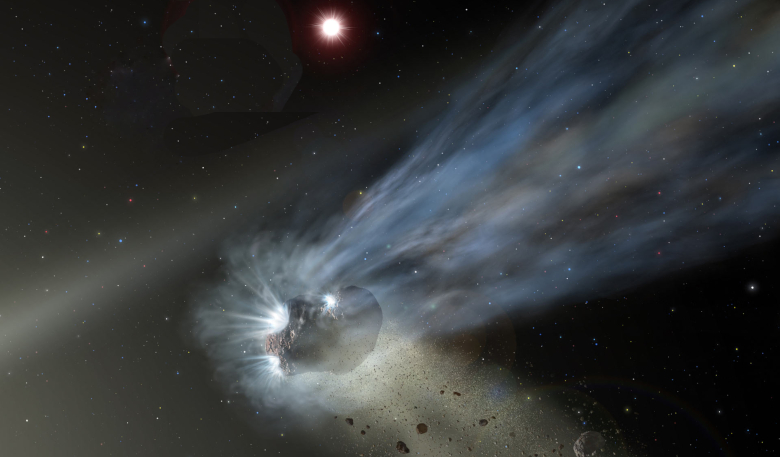Since its arrival in August 2019, scientists have been diligently observing an icy interloper, which soon became identified as the second known interstellar object to visit our Solar System, comet 2I/Borisov. With telescopes trained to watch its passage through our cosmic backyard, two new separate studies published in Nature today have revealed that the visitor is not your average comet, as it packed with carbon monoxide (CO) suggesting it is likely to have formed in a cold region of its home planetary system, far from its host star.
In the last few years, astronomers have had glimpses of other worlds, or rather pieces of planets from far-off systems that somewhere along the line, got booted out of their orbits and flung on a trajectory towards our Sun.
The first—1I/’Oumuamua—was detected in October 2017, but by the time it was discovered it was already on it’s way back out of the Solar System. This made detailed studies of the object difficult, but astronomers around the globe were quick to take as many observations as possible before it disappeared.
From the information gathered, scientists were able to discern that ’Oumuamua’s elongated, cigar-shaped body was quite unlike the cometary objects that populate our Oort Cloud, as it didn’t show the usual tell tale sign of a coma (a comet’s tail). Comas appear when the object heats up near the Sun and volatile compounds on its surface are released as a gas.
This outgassing makes it possible to probe the chemical composition of the comet’s nucleus, however, no detectable levels of gas or dust were detected for ’Oumuamua.
Comet 2I/Borisov on the other hand has turned out to be a more traditional type of comet; a condensed ball of gas, ice and dust that formed in a star’s protoplanetary disk during the formation of its planets and has remained relatively unchanged since.
This ancient relic, and others like it, are therefore windows into the past and they can help astronomers understand how chemical compositions and abundances vary with distance from a central star.
Knowledge of extrasolar comets is very limited, so comet 2I/Borisov’s arrival was a much welcomed event, especially since its brightness and location in the sky has made it observable for months.
Keeping a close eye on this interstellar interloper are two separate teams headed by Dennis Bodewits and colleagues, and Martin Cordiner and colleagues who have used the Hubble Space Telescope (HST) and the Atacama Large Millimetre/submillimetre Array (ALMA), respectively to observe the comet.
Both collected data from observations taken between December 2019 and January 2020, when the comet was at a distance of roughly 2 au (astronomical units) from the Sun (approximately 300 million kilometres), just outside the orbit of Mars and both teams have reached the same result; 2I/Borisov has a large abundance of carbon monoxide (CO) in its coma, more so than is expected for a comet found at a similar distance from our Sun.
Water is typically the most abundant molecule found in the coma of comets in the Solar System, but both papers indicate that while H2O on 2I/Borisov reached a peak production rate around 8 December 2019, before rapidly decreasing again, CO levels remained constant with a possible maximum occurring around 30 December 2019.
From their observations, the teams calculated that 2I/Borisov contains 0.7–1.7 times as much CO as water. Or to put it another way, CO is more than three times higher than previously measured for any comet in the inner (<2.5 au) Solar System.
Because the comet is so rich in CO, it likely originated in a very cold region probably beyond the CO ice-line in a region analogous to our Solar System’s own Kuiper belt, where CO could be frozen onto the comet’s nucleus, suggest both authors in their respective papers.
After the comet was ejected from its original environment, its foray through the cold expansive wastes of interstellar space helped preserve its chemical make-up for millions or even billions of years until the warmth of the Sun eventually caused the ice to heat up and vaporise.
Dennis Bodewits who is based at Auburn University, Alabama, US and his international team of colleagues suggest that given the abundance of CO to H2O in the comet, 2I/Borisov possibly originated around an M-type star - one of the most common stars in our galaxy.
As these types of stellar object have low temperatures and luminosities and form late in their respective stellar neighbourhoods, it would place the CO snowline at nearly 6.6 au from its host star; a distance that would both form and preserve the CO/H2O ratio found within 2I/Borisov.
This is view is also supported by Martin Cordiner at NASA’s Goddard Space Flight Center and his international colleagues, who have also observed hydrogen cyanide (HCN) outgassing from the comet too.
Cordiner and colleagues say that as the HCN abundance relative to water appears similar to that of typical, previously observed comets in our Solar System, the abundance of CO suggests that “2I/Borisov must have formed in a relatively CO-rich environment—probably beyond the CO ice-line in the very cold, outer regions of a distant protoplanetary accretion disk.”
While it is difficult to be sure that the observed coma abundances represent the bulk composition of volatiles in 2I/ Borisov’s nucleus write Cordiner and colleagues in their research paper, “the detection of HCN and CO emission from the first confirmed, active interstellar comet represents a major breakthrough, providing unprecedented insights into the chemistry of a planetary system other than our own,” the authors conclude. One that many hope will be a reoccurring phenomena.











